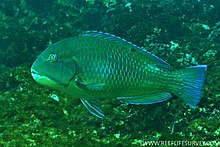The blackspot tuskfish (Choerodon schoenleinii) is a wrasse native to the Indian Ocean and the western Pacific Ocean from Mauritius to Indonesia and Australia north to the Ryukyu Islands. This species occurs on reefs, preferring areas with sandy substrates or areas of weed growth. It can be found at depths from 10 to 60 m (33 to 197 ft), though rarely deeper than 20 m (66 ft). It can reach 100 cm (39 in) in TL, and the greatest published weight for this species is 15.5 kg (34 lb). It is important to local commercial fisheries and is also farmed. It is popular as a game fish, in particular with spearfishers, and can be found in the aquarium trade.[2]
| Blackspot tuskfish | |
|---|---|

| |
| Scientific classification | |
| Domain: | Eukaryota |
| Kingdom: | Animalia |
| Phylum: | Chordata |
| Class: | Actinopterygii |
| Order: | Labriformes |
| Family: | Labridae |
| Genus: | Choerodon |
| Species: | C. schoenleinii
|
| Binomial name | |
| Choerodon schoenleinii (Valenciennes, 1839)
| |
| Synonyms[2] | |
| |
In Hong Kong, its Cantonese name, tsing yi (Cantonese:青衣), has been given to an island (see Tsing Yi).

Etymology
editThe fish is named in honor of Johann Lucas Schönlein (1793-1864), the German naturalist and professor of medicine.[3]
Documentation of tool use
editIn July 2011, a professional diver photographed a blackspot tuskfish bashing a clam on a rock to break the shell, apparently a use of the rock as a tool, the first documented example of tool use in wild fish.[4]
References
edit- ^ Fairclough, D.; Nakazono, A.; et al. (Grouper & Wrasse Specialist Group) (2004). "Choerodon schoenleinii". IUCN Red List of Threatened Species. 2004: e.T44669A10933431. doi:10.2305/IUCN.UK.2004.RLTS.T44669A10933431.en. Retrieved 20 November 2021.
- ^ a b Froese, Rainer; Pauly, Daniel (eds.). "Choerodon schoenleinii". FishBase. August 2013 version.
- ^ Christopher Scharpf & Kenneth J. Lazara (22 September 2018). "Order LABRIFORMES: Family LABRIDAE (a-h)". The ETYFish Project Fish Name Etymology Database. Christopher Scharpf and Kenneth J. Lazara. Archived from the original on 22 February 2023. Retrieved 27 February 2023.
- ^ Brown, Mark (July 11, 2011). "Diver captures first image of fish using tools". Wired Magazine. Condé Nast Publications. Retrieved 12 July 2011.
Tool use in fish, however, is much more rare, and there's never been any photo or video evidence to prove it -- until now.
External links
edit- Photos of Blackspot tuskfish on Sealife Collection
